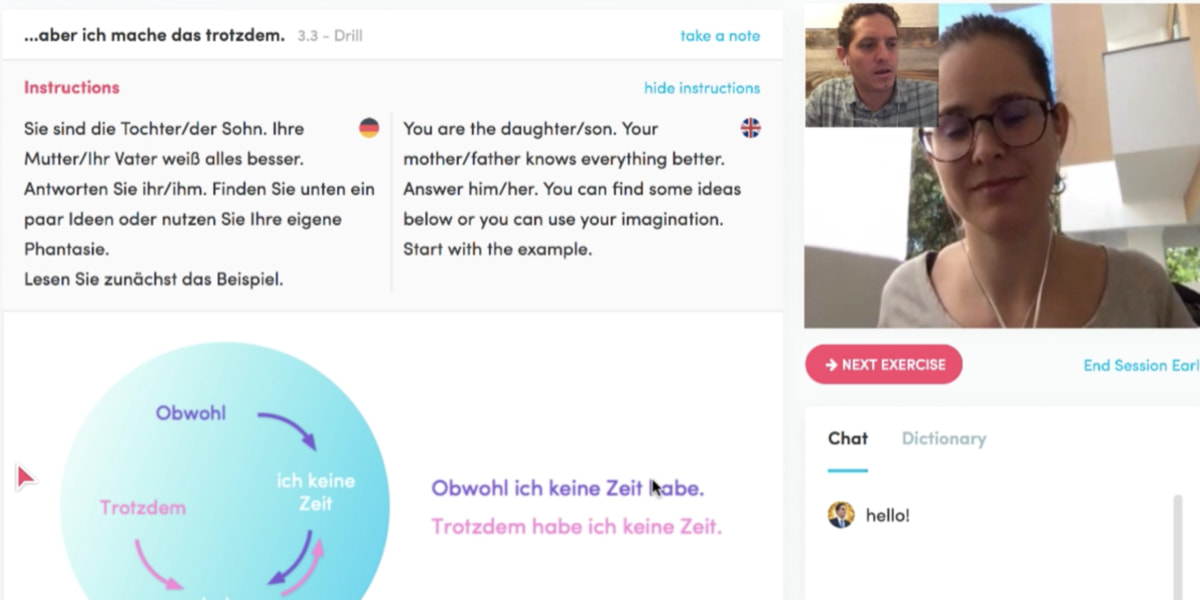Learning German is tough. With its gendered nouns, enormous compound words and confusing clusters of consonants, it can seem like an intimidating language.
We already showed you some ways where you can start learning German for free through using online resources.
While many of these are great options, the problem with that approach is that it may not give you the required motivation or accountability, nor does it give you ongoing feedback or tutoring.
But don’t lose hope! There are plenty of services out there offering you help on the road to fluency.
Invest in yourself and learn German faster…
If you’re looking to really improve your German and are willing to have some skin in the game, which paid services are out there and, most importantly, how do you get the most effective return for your money?
We’ll talk you through the different paid options out there. From language schools to apps and online tutors, we’ll break down the pros and cons of each.
Let’s look at some more traditional approaches to learn German first, and see what each has to offer.
Traditional language schools
There’s no denying that a traditional language school will offer you effective tuition. German language courses are available at community colleges (Volkshochschule) across the country. In addition, the government-financed organisation Goethe Institut have hundreds of schools, both in Germany and around the world.
Attending a school and having live, face-to-face lessons has many benefits:
You can ask questions in real time, and you’re immersed in the learning environment, surrounded by fellow students who can help with your studies. It’s a tried and tested approach, as long as you’ve got the time and money to commit to it.
However, physically attending a language school can become very time-consuming. Factor in travel time, and you might be committing three or four hour chunks of your time each week. Lesson times can be quite inflexible too, so it may become a somewhat odious cloud over your weekly social calendar.
There’s also the issue of term times. Language schools, much like other schools, will break for half term and summer and Christmas holidays for example. This can lead to some big gaps in your tuition, often at times of year when you will have the most time to commit to lessons.
Language schools also ask you to make something of a commitment to your teacher. If you don’t get along with your teacher, or find that their particular teaching methods don’t suit your needs, it can difficult – or even impossible- to switch tutor during the course.
Another big downside is class size: When you’re sharing your tutor’s attention with a whole class of 15 – 30 other students, you might not get as much actual speaking practice as you would hope.
Language and vocabulary apps
There are some great paid apps out there for help with German grammar and vocabulary. Popular favourites like Babbel and duolingo are fantastic for getting you started. If you’re a total beginner, or just trying to learn common phrases for a short trip or holiday in Germany, these are perfect.
However, if you’re an expat living in Germany (or planning to move soon) you may find these apps lacking.
They only really help with vocabulary, grammar and written comprehension. It’s harder for them to offer you speaking or listening practice, which are essential if why you want to learn German is to participate in everyday life. If you live in Germany, and you’re constantly surrounded by native speakers, believe me when I say that talking is the part that’s really going to move the needle for you.
If you’re trying to join in with a conversation, you might feel anxious to attempt speaking if you’ve only had very limited opportunities to practice your German out loud before.
Private teachers
You can get private language tuition in person, or online via platforms like Italki. Each option comes with its own set of pros and cons.
If you meet a private language teacher face-face, you should receive a good standard of learning. You’ll be able to practice the all-important factor of actually speaking German, and you should be able to cultivate a personal relationship tailored to your own unique goals (depending on the quality of your teacher of course!).
The downside of real-life private language tuition is that it tends to be very expensive. You’re paying for someone’s time, on a one-to-one basis, and that isn’t cheap. Prices up to €40 per hour are not uncommon.
Online tuition can be cheaper, but you may still encounter the same problems with time commitment and inflexible schedules that we mentioned when discussing language schools. If the tutor’s schedule doesn’t fit with yours, it can lead to some real headaches.
Another major drawback with private tutors is that each tutor will have their own method and lesson plan. There’s no standardised model or curriculum, so if you change teachers at any point it could be a very jarring transition.
Chatterbug
Chatterbug is a new online platform for learning German. It mixes the best things about personal tuition and apps like duolingo, without the drawbacks. Essentially, Chatterbug gives you remote, on-demand access to lessons and – most importantly – conversation practice with real German natives.
Here’s how it works:
First you’ll have to create an account, but the process is as quick as choosing a username and password. You don’t need to give any financial details up front, although you will have to choose a payment plan to keep learning beyond the free trial period.
Once you’re in, you’ll have instant access to German vocabulary and grammar lessons, presented through flashcards. This is an easy, bite-sized way to learn, that mixes new vocabulary with brief exercises to check up on what you’ve learned along the way. As you progress, new exercise cards are added to your ‘deck’ of cards, so the lessons evolve at the same pace as your learning.
Chatterbug gives you feedback on these exercises every step of the way, so you can learn from any mistakes you make. Each level of progress you make with Chatterbug corresponds to a CEFR level (A1, A2, B2). So when you finish level 1, you should be able to pass the CEFR A1 test. So this pairs fantastically with anyone aiming towards certification.
This might not sound too different from other apps out there, but Chatterbug’s key advantage is that it also offers live video lessons.
You can meet tutors for private video lessons directly on the platform. There’s a built-in calendar where you can check availability of tutors, and schedule a lesson when it’s convenient for you. Chatterbug guides you through conversational exercises and more technical ones – so there’s no need to worry about the lesson plan changing if between tutors. The platform handles the curriculum, not your tutor.
You always have a split screen during video lessons, so you can see your tutor and the exercises that you share with them, and the live lessons use same the vocabulary covered in the self-study flashcards and activities.
As you progress through the curriculum, more developed and challenging activities will become available to you. From writing exercises, to text readings, and even small podcasts and videos, Chatterbug eventually grows to become a full multimedia language course – all focused on spoken German, and getting you talking to natives with confidence as quickly as possible.
All in all, Chatterbug gives you way more speaking practice than an app, more flexibility than a traditional school, and better value for money than a private tutor. What’s more, you can use Chatterbug on the go, from home, however and whenever you like.
If you’re seriously trying to learn German and are interested in giving Chatterbug a try, you can start your free trial here.
This is a sponsored post by our friends at Chatterbug.










